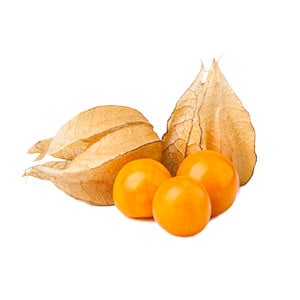Physalis

Physalis
Physalis
Plant family
Solanums (Solanaceae)
Also known as
Husk Tomatoes, Husk Cherries, Poha Berries, Golden Berries, Groundcherries
Season Overview
Propagating
Planting
Harvest
J
F
M
A
M
J
J
A
S
O
N
D
Details
Light requirement
Sunny
Water requirement
Moist
Soil
Medium (loamy)
Nutrient requirement
Medium
Plant distance
80 cm
Row spacing
80 cm
Seeding depth
0.5 cm
Instructions
The season for this plant is over. The following instructions are for the next season.
End of February
Propagating
Mid of March
Mulch
Every 26 Weeks
End of March
Transplanting
Description
Physalis is a genus of about 90 flowering plants in the Solanaceae family. They are native to the Americas and Australasia. The best known edible species are the Andean berry or Cape gooseberry (Physalis peruviana) and the pineapple cherry (Physalis pruinosa). The perennial tropical plant reaches growth heights of about 0.5 to 2 meters/0.5-2.2 yd. It resembles the tomato in many ways - externally, as well as in location requirements and cultivation. It thrives best in a warm and sheltered place with plenty of sun. It does not tolerate frost at all. However, Central European summer temperatures are sufficient to grow a physalis outdoors. Because of our cold winters, it is mainly grown as an annual crop, but it is originally perennial.
Origin:
Their home is in South America.
Growing tips
Sowing begins from the end of January in a warm and bright place. Ideal temperatures are around 25°C/113°F. Physalis are light germinators, but also grow quite well under the ground. The seedlings grow slowly at first and must always be kept moist. After 3 weeks they can then be pricked out. After the Ice Saints, the physalis can then be placed outdoors. About three to four months after sowing, the shrub starts to fruit. Here it is advisable to "plant" a supporting aid directly with it. You can recognize ripe fruits by the brown discolored and dried out cover. If you already have a physalis in your garden, you can cut your own cuttings for the next year after the harvest. These should grow from a leaf axil and be about 10 cm long. Then simply plant them in a pot. Over the winter, place the cuttings in a bright and warm place. Another option is direct seeding at harvest directly into your garden. Crush the fruit between your fingers. Drop them in a suitable location. Do you want to overwinter your physalis? Then I recommend you plant them directly in a tub. Before the first frost comes, place them in a frost-free spot - preferably in a greenhouse or foil tunnel. Pruning in the fall ensures a bushy branched plant.
Companion Plants
Arugula / Rocket
Bean (Dwarf bean)
Bean (Runner bean)
Broccoli
Brussels sprouts
Cabbage (Cabbage)
Cauliflower
Collard greens (Kale)
Collard greens (Tuscan kale / Dinosaur kale / Palm tree kale)
Common marigold
Kohlrabi / German turnip / Turnip cabbage
Lettuce (Lamb's lettuce)
Lettuce (Lettuce)
Onion
Onion (Spring onion)
Spinach (Summer)
Strawberry
Antagonistic Plants
Diseases
Grey mold
Pests
Thrips
White fly